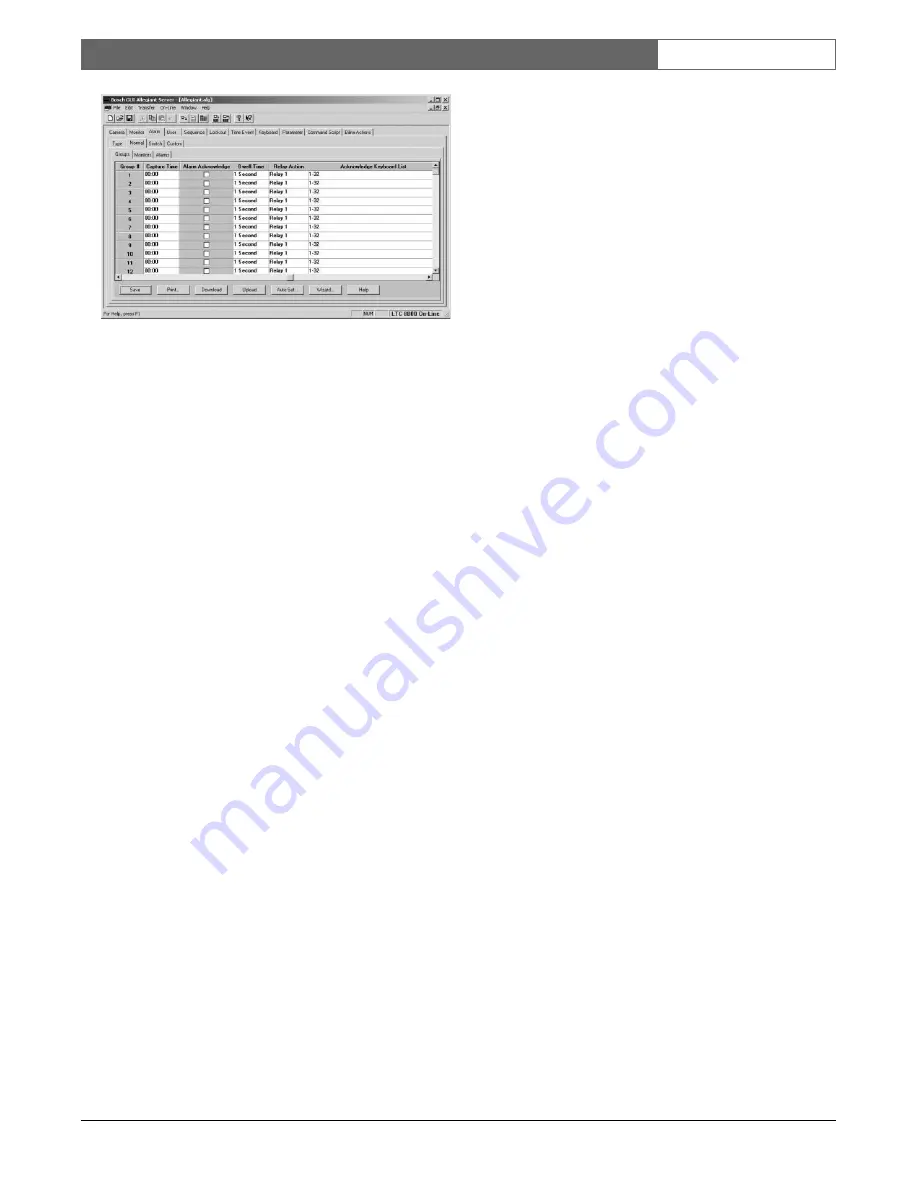
EN
| 38
Bosch Security Systems | 02 April 2004
LTC 8850 |
Instruction Manual
|
Allegiant Server
Figure 73 Alarm Normal Groups after Right
Arrow Selection
Capture Time -
This column is used to specify an
alarm capture time
for video received by a group. A
capture time specifies the MINIMUM amount of time
that alarm videos will be displayed by the monitors of
a group. If the capture time is 0:00 (0 minutes and 0
seconds), alarm video will only be displayed as long as
the alarm input is applied. When the alarm is
deactivated, its video will be immediately cleared from
the group. A non-zero capture time means that alarm
video will only be removed after it has been displayed
for at least the minimum capture time. Alarm capture
time can be set to
FOREVER
, by entering a
-1
, in
which the alarm video can only be cleared by the use
of the
ACKNOWLEDGE
key. See
Alarm
Acknowledge
. To enter a capture time, move to the
appropriate column and enter a time from 0 seconds
(0:00) to 15 minutes (15:00). Or, right click on the cell
to display a dialog box that facilitates a capture time
entry.
Capture Time Operation –
Each alarm video keeps
track of how long it has been displayed in a group.
The time is ONLY counted when the video is actually
being displayed on a
running
step monitor. Time that a
video spends on a review monitor is NOT counted
toward the capture time. Also, a video capture time is
only being used when it is currently being displayed.
Finally, capture time is not used up when a user stops
the sequencing of the step monitor with the
HOLD
key to get a better look at a particular video. After a
video's capture time has expired, the video will
automatically be cleared if the alarm has been
deactivated. Alarm video is only removed when the
alarm has deactivated and its capture time has expired.
NOTE: A user may be disabled from acknowledging
an alarm video which clears it. See
Alarm
Acknowledge
.
Alarm Acknowledge -
This field is a check box used
to indicate whether users can remove alarm video
from monitors by pressing the
ACK
(Acknowledge)
key on their keyboards or from the GUI Event
Handler. If a keyboard is beeping because of an alarm,
pressing
ACK
once will merely silence the beeper.
This behavior is not affected by the value of the Alarm
Acknowledge field; however, subsequent presses of the
keyboard
ACK
key and all presses of the GUI Event
Handler
ACK
button are affected by this field. If the
Alarm Acknowledge box is not enabled, subsequent
presses will result in an error message. However, if the
Alarm Acknowledge box is enabled, the
ACK
key will
remove the current alarm video from the monitor
connected to the keyboard. This only works if the
monitor’s alarm switcher is stopped; trying to
acknowledge video while the switcher is running will
result in an error. The alarm switcher can be stopped
just like the sequence switcher, by pressing the
HOLD
key on the keyboard or the Sequence Stop button in
the GUI Event handler. Pressing
ACK
will remove an
alarm video even if the alarm is still active or the
capture time has not expired.
Alarm Acknowledge Operation –
The
ACK
key will
always affect the monitor currently connected to the
keyboard. The
GUI ACK
button will always affect the
monitor associated with the selected monitor icon or
selected in the Alarm icon control panel. Either
operation might remove the associated alarm video
from other monitors in the group. If there are two or
more review monitors, a given video must be
acknowledged from each one before it will disappear
from the alarmed step monitors. This can be useful if
two different users must review and acknowledge
alarm video before it is removed from the system.
Alarm video can also be acknowledged from a step
monitor, but its switcher must first be stopped with the
HOLD
key. When an alarm video is acknowledged on
a step monitor, it is immediately removed from ALL
of the group’s monitors. This is a quick way of getting
rid of spurious alarm videos. If video should always be
reviewed before it is discarded, users must be careful
not to accidentally acknowledge video on step
monitors.






























